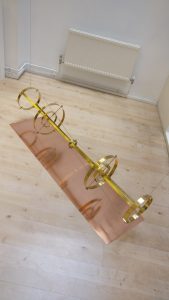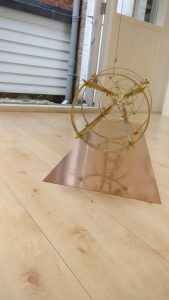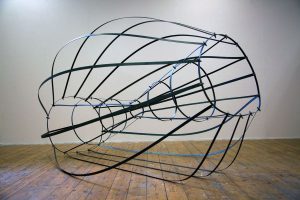As part of the University of Birmingham’s CAL PGT Research Placement Scheme 2018 , I have had the wonderful opportunity to get involved with the Midlands Art Papers and the various cultural institutions across the Midlands. Part of this research placement involves the publication of an article in the upcoming second volume of MAP.
‘The Space Between Gender’
Between the 11 June and 14 July 2018, the RBSA exhibited ‘The Space Between Gender’, a solo show of sculpture by the artist Yazmin Boyle. Boyle was awarded the exhibition as a prize during the New Art West Midlands exhibition (NAWM) in 2017.
The aim of this article is to look at the influence of gender on the sculptural pieces of this exhibition, with particular attention on Unskinned corsetry enters stage right (2018). I had to opportunity to meet Yazmin and discuss the themes of her solo show with her. What emerged during this conversation was an intriguing foray into the themes of femininity and masculinity in her work, the role of feminism and within that, the positives of anger and negatives of aggression. There is a tension between these two positions, echoed in the push and pull in her work and how she plays with materials.
In conversation with Yazmin Boyle

CL: I think your use of materials really helped with the occupation of [the gallery] space, the play between the open Unskinned corsetry, its open skeletal structure, over the slightly reflective rectangle. It made it seem a lot more present.
YB: yeah, I was trying to stage her. If you see her now in the RBSA, she’s got no platform. She’s standing upright pushed in a corner. When she’s vertical, it doesn’t really do a lot, she becomes very masculine and doesn’t fill the space, doesn’t perform. There’s no sense of movement.
CL: I really enjoyed crouching down and looking through the main piece and seeing the bolts and the embossed interior. The doors were open during my visit and it was moving, was that intentional?
YB: […] that was a happy accident and the breeze from the open doors, that movement, really encouraged the work. That oscillation was like a birth canal moving about or a channel [which] amplifies the themes more, and they merge.

CL: I really enjoyed, in your statement, the discussion of the processes and your identification as a maker, that it seems like you get as much joy or fulfillment from the process as the product.
YB: Most definitely. […] You get a buzz out it, it’s like an urge. For me, it’s an obsessive compulsion. Once the main project is completed, it’s like, okay, what’s the next thing. […] I think the idea of perfection is very much within the art world and art society. Or I think so anyway. I’m trying to eradicate that […] Just make, just do, just see what comes of it there and then, play, concrete your theory [so] when you’re taking your theory into the materials, it’s already there.
CL: It’s all about that push and pull, that play. What was on display was a very hard material but it’s intriguing to here that it was a material you manipulated and played with to get to that point.
YB: Yeah. So I’m a printmaker but I like to go back into sculpture, so there’s the play between techniques as well. Taking something two dimensional and then putting it back into something sculptural. My work now is more about items and materials that infer femininity and feminine ideals. At the end of the day, it’s all play and if you don’t try it, you’ll never know.
CL: Did your statement on your website regarding the cosmological come into play with your solo show?
YB: That’s very much part of my previous work [Orbita]. It’s still interesting in that use of space and infinity. I was looking into a lot of pattern-making at the time, and the use of women within science fields. And again, these fields that we associate with the masculine and how women don’t really get a look in. Or they don’t get that kind of representation and the fame that they should. […] I always explain art as another way of looking at something else, be it political, be it – well, everything’s political. And me, in my expression as a woman, and the way I’ve been constructed as a woman, is it social or is it me?

CL: Would you think then that your work is or would you consider your work feminist?
YB: yes, most definitely. I am definitely a feminist but […] I have feminist friends that are quite aggressive and I think aggression against aggression is never going to get anywhere. We all need a sense of equality […] But you need to educate people, [not] fight with them. A lot of feminists are arguing amongst themselves but [it] is multi-faceted, and fighting aggression with aggression is sometimes not positive. I don’t know how you’d view that.
CL: […] there is something quite restorative in being able to identify the fact that, as a woman or someone who has been constructed or socialised as a woman, I am angry […] Because that is something that is considered a feminine or appropriately feminine emotion. Aggression is slightly different. When you’re aggressive, you close the door on people who might be willing to listen but I think that anger had a valid place in art. But aggression puts people on the defensive –
YB: You’ve lost your argument automatically.
CL: But the problem then is sometimes people see anger as aggression because it’s easier and it’s an easy why for you to shut it out and shut it down.
YB: And as a woman, most definitely.
CL: But in the exhibition, I think there was space to interpret it how you wanted to and that it was more defiant than aggressive, for me, when I was thinking about it in relation to your statement, looking at the work of Barbara Hepworth and Richard Serra, whom you mentioned in your statement. For me, Unskinned corsetry was defiant in its presence and occupation of space.
YB: You already had the knowledge behind it. That’s why education is important, isn’t it? These kinds of themes have always encompassed my work and winning the NAWM prize of the solo show was great. The space was a bit weird anyway, obviously, with the cafe and the little shop, and I’d already shown Unskinned corsetry for an assessment so I wanted to try something different. I’d not got a tutor behind me and a lot of my 3D pieces which were on the plinths were negated in tutorials and critiqued. They were 3D printed so I went through a stage of going through designs and models and then they were sent off. I couldn’t do that at uni.
CL: there was a small piece that looked like a more angular miniature version of Unskinned corsetry and made me think of a ring, which echoed the jewellery exhibition on at the time, Shape Up!, an unintentional connection, I’m sure.
YB: Well, it was a technique that I’d never done. I like drawing virtually, plotting out space and shapes. These macquettes, yeah, they could be brooches – it can become quite commercial […] I wanted to show them, to see what they did in the space. That’s kind of part and parcel of when you’re an artist. You curate a space, see how it works, you edit, you move, you see what light works and what doesn’t. The use of the plinths was also quite poignant. I wanted them to be beautiful but to not take away from the pieces. And obviously, you had that square of leather which is bodily, it’s animalistic, it’s tactile. They came from designer leather handbags. That use of materials, of hard and soft. I always refer back to the Fibonacci spiral. When you come to geometry, the curve and the straight line, really old school masculine and feminine.
Yazmin Boyle’s Unskinned corsetry enters stage right is currently on show at the RBSA as part of their ‘Next Wave‘ exhibition. Admission is free.
Time for one more read?
If you enjoyed today’s post, you might enjoy our recent post ‘Artist In Focus: Frank Brangwyn’ Exhibition At The Dudley Museum.
